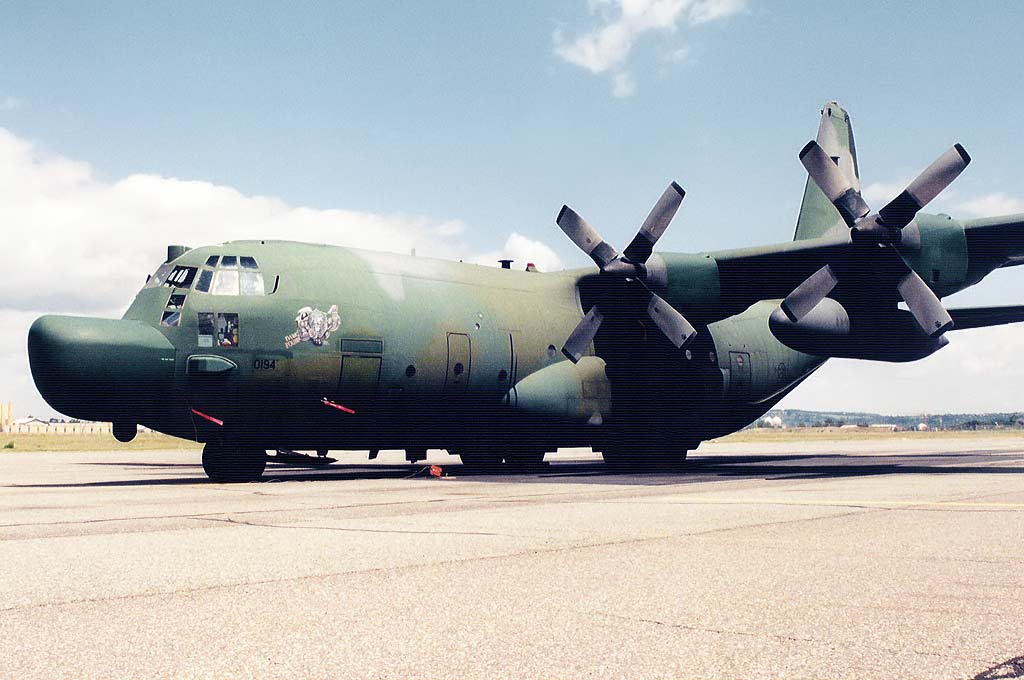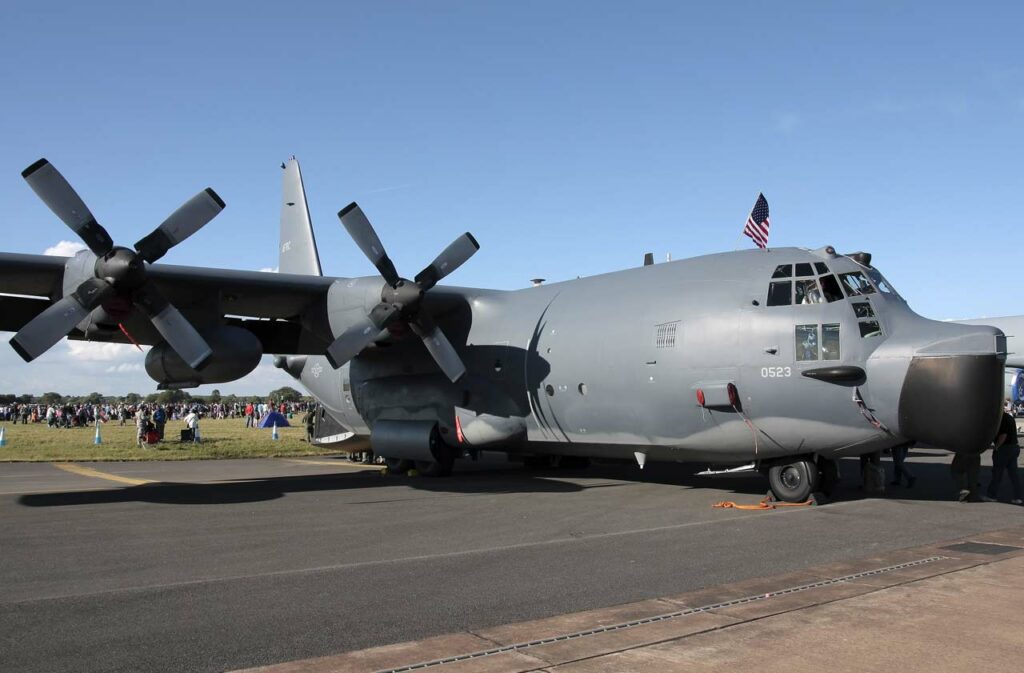The Lockheed MC-130 Combat Talon is a specialized aircraft for infiltration, exfiltration, and resupply of special operations forces, featuring advanced avionics and refueling capabilities.
In brief
The Lockheed MC-130 Combat Talon is an integral part of the United States Air Force’s special operations arsenal, designed for missions requiring clandestine, low-level, long-range insertion, and extraction of elite troops. Equipped with sophisticated navigation and electronic systems, it can operate in adverse weather and terrain. The MC-130 features terrain-following and terrain-avoidance radar, forward-looking infrared sensors, and is equipped for aerial refueling as well as refueling other aircraft. Its versatility is further enhanced by its ability to airdrop personnel and cargo, perform psychological operations, and other specialized missions. It’s a multi-role aircraft that combines technology and performance to support unconventional warfare and special operations worldwide.
The Lockheed MC-130 Combat Talon represents a pinnacle in the evolution of military aviation, specifically tailored to meet the unique demands of special operations. Its development was driven by the need for an aircraft capable of performing precision, low-level, long-range missions to deploy, resupply, and extract special operations forces in hostile or denied territories.

History of the Development of the Lockheed MC-130 Combat Talon
The MC-130’s genesis was during the Cold War, a period that necessitated a platform capable of delivering special operations forces behind enemy lines with precision and stealth. The aircraft’s development was initiated by the U.S. Air Force in the early 1960s, responding to the increasing requirement for a specialized aircraft that could support covert operations, particularly in the context of the escalating Vietnam War and the broader Cold War confrontations.
Lockheed, building on the success of the C-130 Hercules, modified the airframe to produce the MC-130E Combat Talon I, which first flew in 1966. This variant was specifically designed to penetrate hostile airspace at low altitudes and night, delivering operatives and equipment with high accuracy. The aircraft was equipped with cutting-edge technology, including terrain-following radar, which allowed it to fly at low altitudes to avoid detection and to perform airdrops and landings in complete darkness or adverse weather conditions.
The necessity for such an aircraft stemmed from the evolving nature of global military engagements, where conventional large-scale conflicts were complemented by guerrilla warfare and other forms of irregular combat. The MC-130 was conceived to support these new warfare paradigms, providing a strategic advantage in deploying special operations forces for precise, high-risk missions.
Design of the Lockheed MC-130 Combat Talon
The MC-130 Combat Talon’s design incorporates several unique features tailored to its special operations role. It has advanced navigation and electronic warfare equipment, enabling it to penetrate enemy airspace at low altitudes undetected. The aircraft is equipped with terrain-following and avoidance radar, allowing it to maintain a low flight profile in mountainous terrain or at night, minimizing exposure to enemy radar.
The airframe of the MC-130 is reinforced to withstand the stress of low-altitude flights and is capable of air-to-air refueling, which extends its operational range and endurance significantly. The aircraft also features specialized equipment for in-flight refueling of helicopters, enhancing the operational flexibility of rotary-wing assets in the field.
The MC-130’s cargo compartment is configured to support a variety of missions, including the transportation of personnel, the airdrop of supplies and equipment, and the deployment of psychological warfare materials. The aircraft’s versatility is further augmented by its capability to operate from austere and improvised airstrips, enabling the resupply of special operations forces in isolated locations.
Performance of the Lockheed MC-130 Combat Talon
The MC-130 Combat Talon is powered by four Allison T56 turboprop engines, each providing robust power, enabling the aircraft to achieve a top speed of approximately 300 mph with a range of over 2,500 miles without aerial refueling. Its service ceiling exceeds 33,000 feet, but operational missions are typically flown at much lower altitudes. The aircraft’s performance is optimized for low-level, high-endurance missions, requiring precise navigation and payload delivery in challenging environments.
Comparatively, the MC-130’s unique capabilities set it apart from other transport aircraft, making it particularly effective for special operations missions that conventional platforms cannot perform. Its blend of speed, range, and low-level flight capabilities, combined with advanced avionics, make it a formidable asset in the special operations community.
Variants of the Lockheed MC-130 Combat Talon
The MC-130 series includes several variants:
- MC-130E Combat Talon I: The original version, equipped with electronic warfare systems for penetration of hostile airspace.
- MC-130H Combat Talon II: Introduced improvements in avionics, refueling systems, and enhanced cargo-handling capabilities.
- MC-130P Combat Shadow: Focused on refueling special operations helicopters and carrying out resupply missions.
- MC-130J Commando II: The latest variant, featuring advanced technology, improved performance, and greater efficiency.
Each variant of the MC-130 has been designed with specific missions in mind, enhancing the aircraft’s versatility across a wide range of special operations demands.

Military Use and Combat of the Lockheed MC-130 Combat Talon
The MC-130 Combat Talon has been extensively used in numerous conflicts, providing critical support to special operations. It has played pivotal roles in missions ranging from the covert insertion of forces into hostile territories to the recovery of personnel behind enemy lines. The aircraft’s capabilities have been demonstrated in various operations, including the attempted rescue of American hostages in Iran during Operation Eagle Claw and supporting missions in the Gulf Wars, Afghanistan, and other global hotspots.
The MC-130’s armament typically includes defensive countermeasures but can be configured to carry precision-guided munitions in some variants, enhancing its role in direct support of special operations forces. Its operational success is attributed to its ability to operate in denied environments, delivering and extracting troops with precision and supporting extended operations through its refueling capabilities.
The Lockheed MC-130 Combat Talon is a cornerstone of U.S. Air Force special operations, embodying a unique blend of versatility, precision, and capability. Its development and continued evolution reflect the changing nature of warfare and the increasing importance of special operations forces in modern military strategy. The MC-130’s specialized design, advanced technology, and proven combat performance have solidified its reputation as an indispensable asset for unconventional warfare and special operations missions worldwide.
Back to the Special Aircraft section